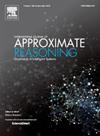An approach to calculate conceptual distance across multi-granularity based on three-way partial order structure
IF 3.2
3区 计算机科学
Q2 COMPUTER SCIENCE, ARTIFICIAL INTELLIGENCE
引用次数: 0
Abstract
The computation of concept distances aids in understanding the interrelations among entities within knowledge graphs and uncovering implicit information. The existing studies predominantly focus on the conceptual distance of specific hierarchical levels without offering a unified framework for comprehensive exploration. To overcome the limitations of unidimensional approaches, this paper proposes a method for calculating concept distances at multiple granularities based on a three-way partial order structure. Specifically: (1) this study introduces a methodology for calculating inter-object similarity based on the three-way attribute partial order structure (APOS); (2) It proposes the application of the similarity matrix to delineate the structure of categories; (3) Based on the similarity matrix describing the three-way APOS of categories, we establish a novel method for calculating inter-category distance. The experiments on eight datasets demonstrate that this approach effectively differentiates various concepts and computes their distances. When applied to classification tasks, it exhibits outstanding performance.
基于三向偏序结构的多粒度概念距离计算方法
概念距离的计算有助于理解知识图谱中实体之间的相互关系,并揭示隐含信息。现有研究主要关注特定层次的概念距离,而没有提供一个统一的框架来进行全面探索。为了克服单维度方法的局限性,本文提出了一种基于三向偏序结构的多粒度概念距离计算方法。具体来说:(1) 本研究介绍了一种基于三向属性偏序结构(APOS)计算对象间相似性的方法;(2) 本研究提出了应用相似性矩阵划分类别结构的方法;(3) 基于描述类别三向 APOS 的相似性矩阵,我们建立了一种计算类别间距离的新方法。在八个数据集上的实验证明,这种方法能有效区分各种概念并计算它们之间的距离。在应用于分类任务时,它表现出了卓越的性能。
本文章由计算机程序翻译,如有差异,请以英文原文为准。
求助全文
约1分钟内获得全文
求助全文
来源期刊

International Journal of Approximate Reasoning
工程技术-计算机:人工智能
CiteScore
6.90
自引率
12.80%
发文量
170
审稿时长
67 days
期刊介绍:
The International Journal of Approximate Reasoning is intended to serve as a forum for the treatment of imprecision and uncertainty in Artificial and Computational Intelligence, covering both the foundations of uncertainty theories, and the design of intelligent systems for scientific and engineering applications. It publishes high-quality research papers describing theoretical developments or innovative applications, as well as review articles on topics of general interest.
Relevant topics include, but are not limited to, probabilistic reasoning and Bayesian networks, imprecise probabilities, random sets, belief functions (Dempster-Shafer theory), possibility theory, fuzzy sets, rough sets, decision theory, non-additive measures and integrals, qualitative reasoning about uncertainty, comparative probability orderings, game-theoretic probability, default reasoning, nonstandard logics, argumentation systems, inconsistency tolerant reasoning, elicitation techniques, philosophical foundations and psychological models of uncertain reasoning.
Domains of application for uncertain reasoning systems include risk analysis and assessment, information retrieval and database design, information fusion, machine learning, data and web mining, computer vision, image and signal processing, intelligent data analysis, statistics, multi-agent systems, etc.
 求助内容:
求助内容: 应助结果提醒方式:
应助结果提醒方式:


